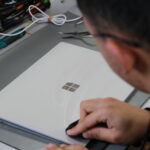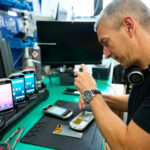How can you extend the life of your computer equipment?
The life cycle of a desktop computer usually ends after 5 years of use. Laptop lifetimes are even shorter. And this is only the visible face of a problem that concerns the entire IT equipment: smartphones, barcode scanners, sales terminals, payment terminals, etc. How can you extend the lifespan of your IT equipment and thus circumvent the limitations set by the manufacturers?
Why control the life cycle of your IT equipment?
The deployment of a company’s IT assets is part of a strategic growth project. It requires significant human, financial and organizational resources. Companies therefore consider this purchase as a long-term acquisition. However, this does not take into account the practices of manufacturers.
How long does a computer last in a company?
According to a SpiceWorks survey of 1,400 US companies, the life cycle of desktop computers is longer than that of laptops. PC performance is 5 years for 70% of companies. The average lifespan of business laptops is only 5 years for 48% of companies.
What about tablets? Only 1% of companies state that their employees use them as their main medium. When this is the case, 42% of companies use them for two years or less, 41% for three to four years.
Smartphones are used for 3 to 4 years. It should be noted that 80% of smartphones are changed while they are still functional!
The life cycle of peripherals is similar to that of PCs. Servers last five years in 75% of companies. Only 32% use them for seven years or more. As for printers, 75% of companies use them for five years or more. Only 37% of respondents use them for seven years or more.
These figures concern the life cycles of office equipment. However, the life cycles of logistics equipment such as barcode scanners and printers present the same problems. This is also the case for retail equipment, including checkout equipment, displays, payment terminals and pin pads.
What life cycle do manufacturers expect for your IT equipment?
What are the life cycles of computers and other IT equipment? For each new piece of equipment, IT manufacturers develop deployment roadmaps:
- New product launch;
- Time of manufacturer’s warranty ;
- Spare parts availability time;
- End of production of new equipment;
- End of manufacturer’s warranty;
- End of OS (Operating System) support;
- End of availability of spare parts.
For a long time, companies have been dependent on this medium-term programme. This is reminiscent of the criticism levelled at programmed obsolescence. The law defines it as “all the techniques by which a marketer aims to deliberately reduce the lifespan of a product in order to increase its replacement rate”.
The quest for the longest life cycle for IT equipment
Until a few years ago, companies still relied on the IT lifecycles planned by manufacturers to deploy their digital transformation projects. They tried to buy new equipment.
The aim was to take advantage of the longest possible use, maintenance and availability of spare parts and equipment. In other words, an optimal life cycle for computers and other equipment.
Once all the timeframes in the roadmap have elapsed, two choices remain:
- Retain the deployed IT equipment and supplement it with a new generation of equipment in the event of breakdowns, breakages or new usage requirements;
- Embark on a long and costly project to renew the IT assets.
This last option is rarely considered, as it is so costly. The first involves the risk of having equipment of different generations coexist. It often gives rise to various operational problems:
- Divergent modes of use depending on the media;
- Multiplication of staff training for equipment that functions differently;
- Reception furniture, support frames, cables and software not adapted to the variety of formats.
No solution therefore solves the issue of managing the life cycles of IT equipment for good.
How can we free ourselves from the roadmaps imposed by the IT brands?
To free themselves from the life cycles of computers and other hardware imposed by manufacturers, companies can choose between 4 paths. To extend the lifespan of an IT asset, you can buy refurbished equipment, have your asset serviced, use spare parts or give new life to unused equipment.
Buying refurbished IT equipment
- Buying refurbished IT equipment has more than one advantage:
- Extend the life of the fleet evenly;
- Avoid changing reception furniture and loading racks;
- Having stocks available at all times, whereas new equipment involves delays;
- Take advantage of lower prices than for new software;
- Use the same version of your software, without having to finance a new development;
- Engage in a high-impact CSR process;
- Do not depend on the manufacturer’s roadmap and change your fleet when you want!
Maintaining your computer equipment beyond the manufacturer’s warranty
Another technique is to go beyond the life cycles of computers and other equipment. It consists of using a computer maintenance service provider, with the following advantages
- Exceeding the manufacturers’ warranty periods by several years;
- Extend the date of your fleet renewal;
- Avoiding delays in the delivery of new equipment;
- Make the old and the new system cohabit, within the framework of the deployment of your new park;
- Reduce the rate of breakdowns and breakages. In the B2B smartphone market in particular, it is not uncommon for the prospect of a repair to discourage some unwary employees from damaging their equipment in the hope of getting new ones.
Extending the lifespan of computers and other devices can also be achieved through the use of spare parts. Spare parts can be used to repair equipment. They also improve their performance for long-term use.
Betting on the reuse of unused equipment
It is important to differentiate between “end of life” and “end of use” of business IT equipment. Companies and users often mistakenly confuse the two concepts, but end-of-use does not mean end-of-life. And if it is essential for companies to extend the end of use of their IT equipment, it is even more important to delay their end of useful life through reuse (in the context of using the equipment as it is or even in the context of dismantling it to use spare parts).
Thus, one way of extending the IT life cycle may also be to engage in a process of reuse of equipment. The life cycle of the equipment is thus extended beyond the company’s walls. The company then adopts a sustainable approach, which reinforces its Corporate Social Responsibility (CSR) policy.
To give your IT equipment a second life, service providers such as Codeo take back and recycle unused equipment. This process requires an audit procedure, which results in the reconditioning of functional equipment.
This equipment can be erased (using specialised software such as Blancco, for example) before being put back on the market to ensure the security of your personal data or that of your employees, customers, etc.
Unusable equipment will be dismantled into spare parts for further reuse. These parts are then used to repair and recondition second-hand equipment. Finally, unusable equipment is recycled.
Do you want to extend the life cycles of your IT equipment? Find out more about our fleet extension, maintenance and trade-in services.




